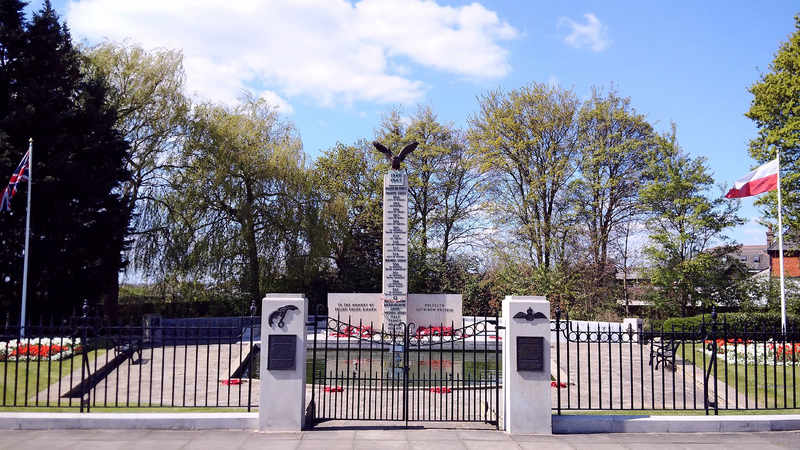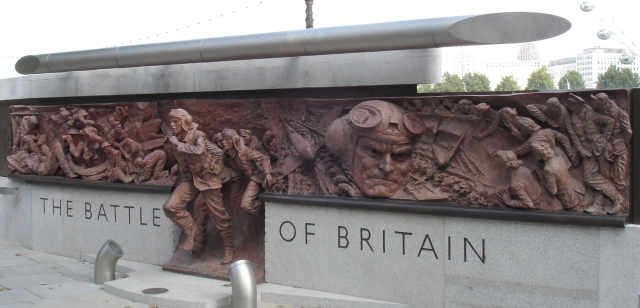The epic victory won by our pilots in the Battle of Britain in the summer of 1940 not only saved the country from invasion but brought undying fame for our Spitfire and Hurricane pilots. Two memorials commemorate their epic deeds.
1. Battle of Britain London Memorial, Victoria Enbankment
This was probably the first RAF memorial to be built after the war. Thousands of Polish airmen flew in both Fighter and Bomber Command during the war. Fleeing Nazi and Russian occupation of their homeland they made a major contribution to the Allied War effort. Many of them settled in England after the war not wishing to return to communist Poland. The memorial was designed and inspired by Mieczylav Lubedski who had taken part in the 1944 Warsaw Uprising being captured and interned in a German concentration camp.
A column of Portland stone is surmounted by a bronze eagle. It commemorates 2,165 Polish airmen killed serving in the RAF. Their names, plus squadron badges, are inscribed on a wall alongside. The memorial was dedicated and unveiled by Lord Tedder (Chief of Air Staff) on 2 November 1948.
4. Plymouth Hoe Memorial
This fine memorial was the brain child of Jim Davis a former Lancaster rear-gunner. It comprises of an imposing granite column surmounted by a bronze statue of an unknown airman in flying kit, sculpted by Mrs Pamela Taylor. A long dedication in gold lettering praises all those who served in the RAF including those from the Commonwealth and various European countries. The memorial was dedicated by Air Marshal Sir John Curtiss on 3 September 1989, the 50th anniversary of the declaration of the Second World War in 1939.
Finally, one overseas memorial must also be mentioned.
5. Malta Memorial, Valletta
The Mediterranean area saw much intense air and sea fighting especially around the island of Malta. RAF squadrons not only defended the island from German air attacks but also protected Allied convoys bringing vital food and fuel supplies to the island. German convoys taking fuel and tanks to Tripoli for General Rommel’s African Corps also had to be attacked.
The memorial designed by Sir Hubert Worthington RA commemorates the 2,300 airmen who flew from bases in the Mediterranean area - Malta, Italy, Sicily, Tunisia, Algeria, Morocco, Gibraltar, Yugoslavia and the Adriatic. A tall 49 foot column on a circular base is surmounted by a golden eagle sculpted by Charles Wheeler RA. It was unveiled by Queen Elizabeth II on 2 May 1954.
An inscription below reads: “Over these and neighbouring lands and seas the airmen whose names are recorded here fell in raids and sorties and have no known grave.
PROPOSITA INSULA TENAT VIROS COMMEMURAN.”
An island resolute of purpose remembers resolute men.
John Symonds
This memorial was conceived by Bill Bond, founder of the Battle of Britain Historical Society. He appointed Donald Insole Associates as architects and raised £250,000 through an appeal. The remainder of the £1.74 million costs came from private donations.
The monument was designed to be at eye-level making it accessible to pedestrians walking along the Embankment. An 82 foot length of granite is carved showing many scenes from the battle. The centre piece for example shows ‘The Scramble’ with pilots rushing towards their planes as enemy aircraft approach. Other friezes depict observers, mechanics, gunners, a ‘dog-fight’, technical staff, St Paul’s Cathedral as well as ordinary Londoners such as hop-pickers. The sculptor was Paul Day. The names of 3,000 men who fought in the battle, including the 546 pilots killed are inscribed on panels alongside. This impressive memorial was unveiled by Prince Charles on 18 September 2005.
2. Capel-Le-Ferme Memorial, Folkestone
Situated high on the Downs overlooking the English Channel the central sculpture, carved by Harry Gray, shows a seated pilot sitting and gazing out to sea towards the French coast. Replicas of Spitfire and Hurricane planes are on site as well as a memorial wall listing the names of the 3,000 men who fought in the battle. It was unveiled by the Queen Mother on 9 July 1993. A more recent addition to the site is a bust of Air Chief Marshal Sir Keith Park who commanded II Fighter Group Fighter Command during the battle. Carved by Will Davies it was unveiled by the Duchess of Cornwall on 31 May 2017. There is also a visitor centre.
3. Polish Air Memorial, Northolt, Middlesex






